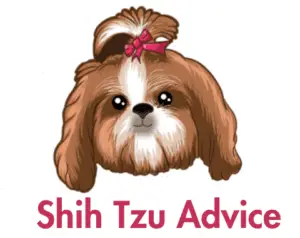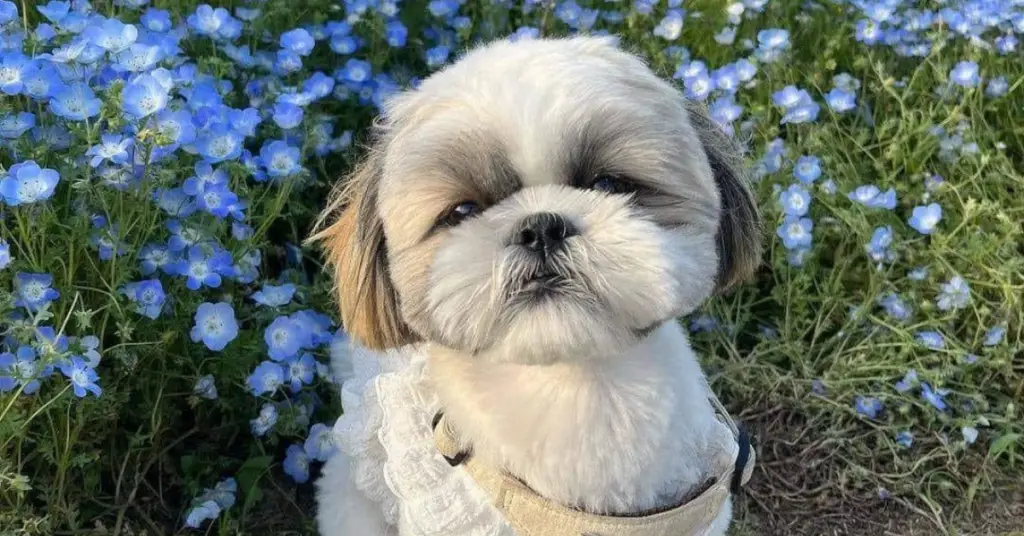
Introduction
In this ultimate Shih Tzu guide, we will tell you everything you need to know about owning a Shih Tzu, from what to feed them all the way to how they should be trained! So read on and we hope our information helps you make an easier decision when coming to purchase your Shih Tzu!
The Shih Tzu is a toy dog breed with a lush and long coat. They are easygoing and affectionate animals with beautiful, large, round eyes, floppy ears, and a short snout. People adore them for their playful, calm, and loving nature. They love to follow their humans from one room to another and do not do well when left alone.
They easily adapt to apartment life and quickly make friends with newcomers. They are meant to be companion dogs and make themselves comfortable on every available lap. However, Shih Tzus have a stubborn streak.
When properly trained, they make for obedient and well-mannered dogs that you will love showing around. However, Shih Tzus are prone to many health conditions—some are genetic while others are avoidable with proper diet and exercise.
All in all, they are a lovely dog breed who will accompany you on your couch, give you lots of love and kisses, and enjoy an evening stroll.
Shih Tzu History
The breed gets its name from the Chinese language meaning “little lion” and is pronounced as SHEED Zoo, SHID Zoo, or SHEET Sue.
The lion was a great part of Buddhism and was highly esteemed. Lions had long been the guardians of their temples and palaces. The lion was a symbol of strength and courage.
The Shih Tzu or the Little Lion was bred to reflect these characteristics along with regality and beauty. They took the place of lions, acting as companions and guardians.
As the dogs were protectors of the temples and palaces, barking was one of the most desirable characteristics. The breeding programs sharpened the characteristic more, a trait still prevalent in the breed.
Today, Shih Tzu is one of the most loved and pampered toy dogs worldwide.
Where do Shih Tzu come from?
There are many theories revolving around the origin of Shih Tzu. According to one theory, the Chinese royalty received them as gifts from the Tibetan monks who developed the dog breed.
According to another theory, the dogs were developed in China by mating different breeds with the Pekingnese or Lhasa Apso.
Regardless of their origin, they were the favorite companions of the Chinese royalty and are one of the most ancient dogs dating back to as early as 8,000 B.C.
They lived alongside trained lions during the Mongolian dynasty in the 13th century. The lions hunted, and Shih Tzus, the small lion dogs, served to keep them calm.
The Ming dynasty documented the presence of small, intelligent dogs that were docile and resembled lions. It is during this period that they rose to claim as the Chinese royal house pets.
The Shih Tzu we know today is the consequence of breeding initiatives conducted during the Qing Dynasty by Empress Cixi in the late 19th century. She loved animals dearly and if she caught anyone tormenting the palace dogs, she put them to death.
All her breeding programs were under the direct supervision of the palace eunuchs. The eunuchs were quite proud of their unique and gorgeous canines. Interbreeding, on the other hand, was sometimes done without the empress’ knowledge. These interbreeding efforts also used breeds like Pekingese and Pugs.
The empress adored her dogs and refused to share them with any foreign visitors or acquaintances.
The Commercialization of Shih Tzus
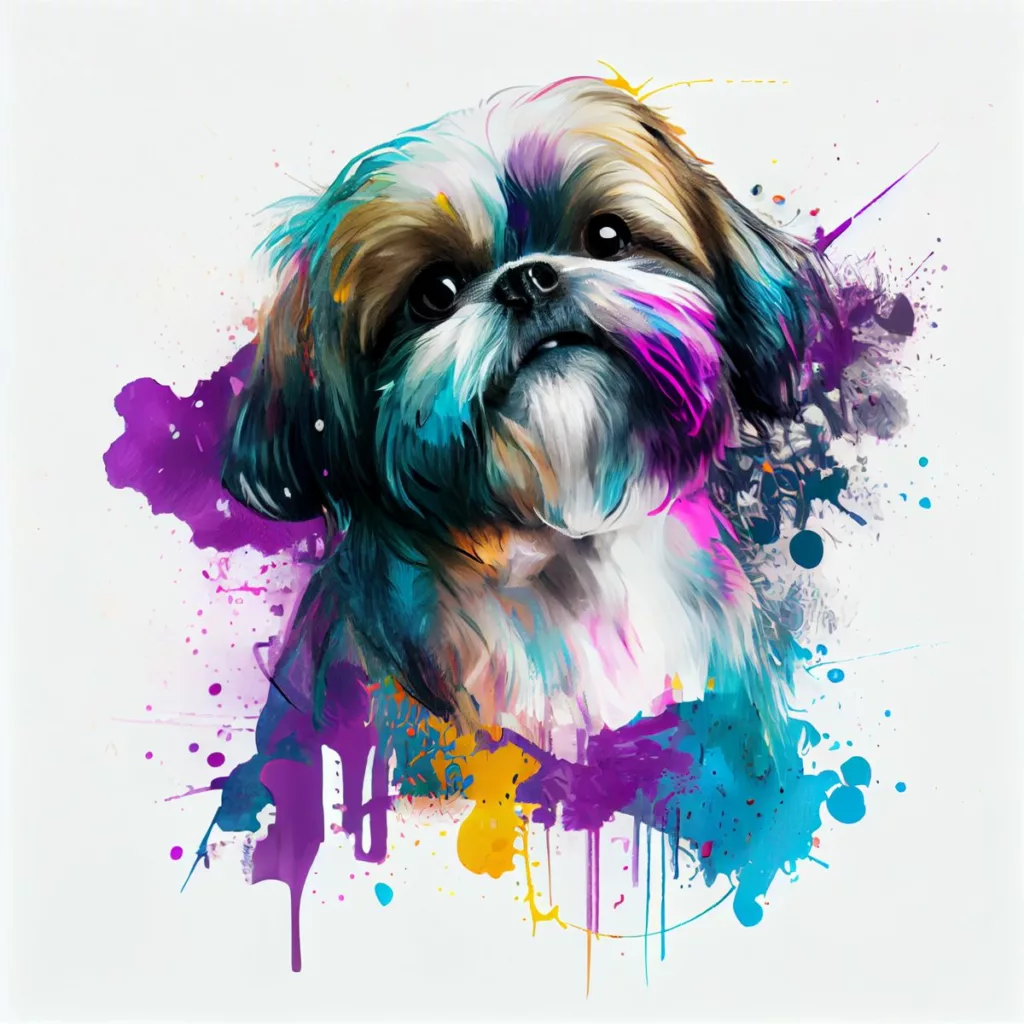
Following the empress’ death, however, numerous royal families raced to breed the best canines with the most desirable characteristics. They sold the low-quality dogs that the breeding schemes produced at markets. They smuggled high-quality dogs out of the palaces and handed them to foreign visitors and Chinese aristocrats.
The dogs were a prized possession of the Chinese royals and they never sold or traded them. In the 1930s, a few made their way to Europe and were classified as “Apsos” by the kennel club. The Shih Tzu Club of England laid down the first European breed standard in 1935.
After the second world war, the U.S. military men brought back dogs from Europe and China. The Shih Tzu was one of these dogs. The American Kennel Club recognized and classified them as a toy group in 1969.
Shih Tzu Breed
The Shih Tzu is a small dog recognized for its distinctive facial features and amazing and abundant locks. It is sturdy, courageous, confident, alert, and also friendly, and playful.
Physique And Appearance
Shih Tzus have a sound bone structure, reaching the height of 8 to 11 inches at the withers, and weighing anywhere from 9 to 16 pounds. It is a true miniature dog and has a body length greater than its height.
The breed has a small and flat muzzle and is categorized as brachycephalic. They usually have large round dark brown eyes and an “owl head” or “lion head”. The ears are long and floppy and covered with fur.
Coat
Its hair is soft and long, is double layered and the lush straight locks can grow past its feet. The breed hardly sheds and is a good choice for people allergic to dog hair.
The luxurious hair can become a tangled mess and gets easily matted if not groomed regularly. The tail is heavily covered in fur and is curled at the back.
The Shih Tzu coat is long and silky, and it comes in a variety of colors, including black, black and white, gray and white, and red and white. A white tail tip and a white blaze on the forehead are highly-sought features.
Shih Tzu Puppies
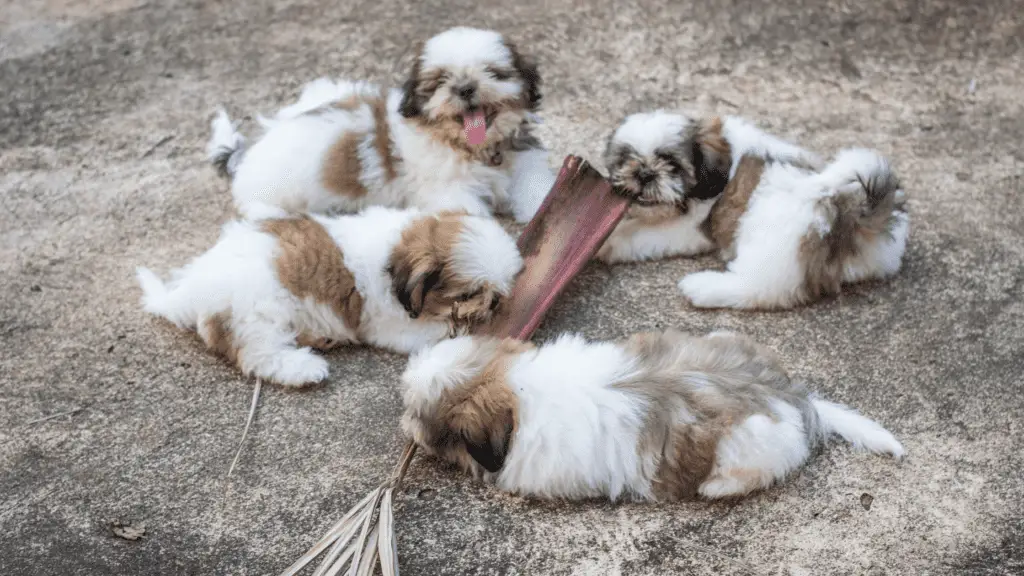
Shih Tzus are very affectionate dogs and love to please people. So potential Shih Tzu owners need to be prepared to be charmed by these beautiful babies. They need minimal exercise, and their small stature makes them ideal apartment dogs.
Shih Tzus, like people, go through various stages of development before reaching adulthood.
Detailed below are the milestones of their developmental stages.
Newborn
Newborn puppies are deaf and blind, with their eyelids and ear canals closed. They have a developing nervous system and exhibit minimal reflexes.
After around 10 days, the puppy opens its eyes. However, its vision is cloudy and will remain the same for the next 2 weeks.
3 Weeks
By this time, the puppies gain complete sight and hearing. They become more active and try to walk around. With vocalization beginning, sounds like peeps and squeaks can be heard. They start playing with their littermates and start recognizing the mother and others around.
6 Weeks
With weaning completed by this stage, puppies venture out of the weaning box to explore their surroundings. This stage marks the start of socialization, so humans can begin holding the pup. It also marks the establishment of tolerance and fears. The fluffy Shih Tzu look starts to develop. You can introduce the puppies to solid food by 6 weeks.
2 Months
This is a phase of rapid growth, so you must provide the puppy with a well-balanced puppy diet. The puppy will also be teething and will require a lot of chew toys. By this time, they start understanding commands, and you can begin house training them.
6 Months
This is the last stage of development. We classify pups as adults after 12 months. In this stage, their growth rate slows down considerably. It marks the beginning of adolescence with puberty on its way. During this stage, the female puppies experience their first heat.
With teething coming to its completion and a slower growth rate, the puppies leave their chaotic behavior for a calmer one. You can introduce the pups to adult food now.
1 Year Old
Deemed as adults, by this time, the Shih Tzu has gained all the characteristics that define the breed. They are alert and highly active. This is the best time to engage them in training. However, they also need relaxation and family time.
Shih Tzu Temperament
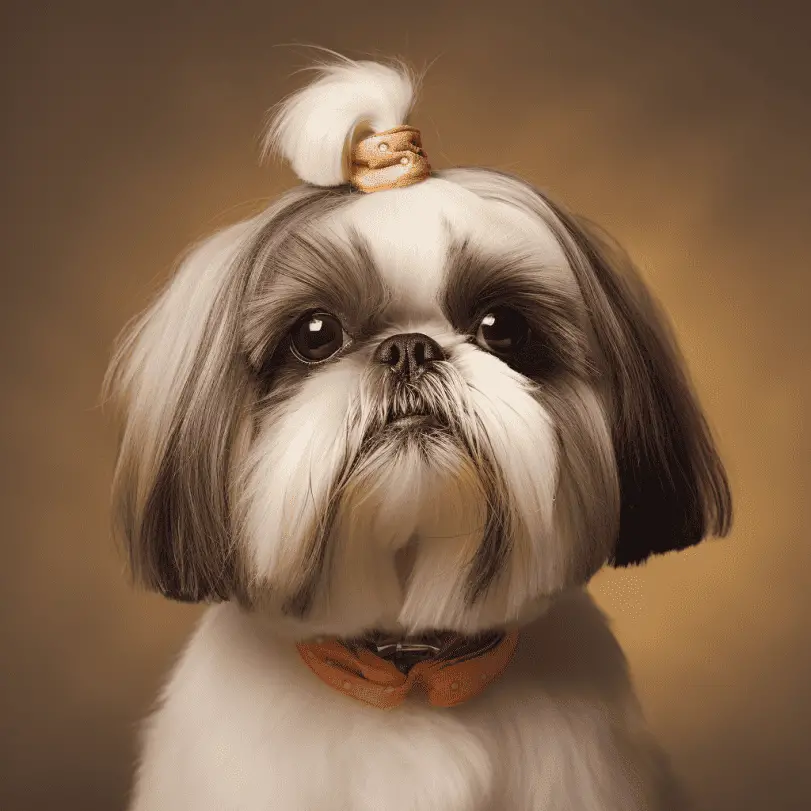
As Shih Tzus were meant to be companion dogs, the breeders chose the dogs who exhibited the best companion characteristics as parents for their next breeding program. This selective breeding gradually increased these traits while eliminating all others.
So expecting them to guard, hunt, or retrieve is unreasonable. However, they will prove to be the friendliest of companions, never leaving your lap unless absolutely necessary. They are naturally affectionate, and you may notice them showering affection on kind family members.
They socialize well with children, but if you introduce children later in life, older dogs may find it difficult to cope with their high energy levels.
Although they are not guard dogs, they are not couch potatoes either. They are alert and will bark at every visitor. However, you don’t have to worry. They make friends just as easily and will dote on them too.
They can get skittish when mistreated and can suffer from anxiety if ignored. This is because the breed is highly people-oriented and constantly needs to be around their humans, making them very clingy. Most of the time, separation from the owner or even their absence can lead to the development of extreme separation anxiety.
Another negative aspect of the breed is their stubbornness and manipulative behavior. It is very important to consistently remind them that you mean what you say. Although food can help you with this, as it is a good motivator, if given too much, the dog will listen only when treated.
Still, it is a lively, happy, friendly, playful, and affectionate breed that loves its playtime and relaxation time equally.
Shih Tzu Grooming
Shih Tzu is a hypoallergenic dog breed. Although this means very minimal shedding, it also means that you need to groom the dog regularly to avoid matting.
While some owners prefer to keep their dog’s hair short and trim, giving it a fluffy appearance, others like their dog’s coat to be long and luxurious. Whether long or short, you need to brush their coat at least once or twice a week and more if you keep it long.
Give them haircuts for facial hair after every few weeks, as facial hair can fall over the eyes and cause irritation and discomfort. The most common hairstyles Shih Tzu’s sport are topknot and bow. Their face gets dirty after eating, so clean it after every meal with a soft, damp cloth.
They also need regular bathing to avoid matted hair. They may need bathing at least once a week or more depending on the coat length. The dog’s nails need monthly trimming. Brush their teeth regularly for good oral hygiene. A soft toothbrush with doggy toothpaste will help ensure they do not develop any dental problems.
Their ears are prone to infection as dirt collects inside them. Check the ears weekly for dirt, swelling, odor, or redness. Clean them regularly with a cotton ball dampened with an ear cleaner. It is important to use a pH-balanced ear cleaner to avoid complications. Hair also grows inside the ear canal, and you will need to pluck it if the puppy is prone to ear infections.
With daily brushing, regular bathing, clipping, and other grooming needs, the gorgeous Shih Tzu is quite demanding. Owners often resort to professional groomers to fulfill their dogs’ requirements with coat grooming appointments every 6 to 8 weeks.
Shih Tzu Weight

Shih Tzu is a dog that grows fast, so it is absolutely necessary to monitor their physical growth like height and weight. This will also help determine the health of the dog. A lag from the statistical average height and weight may indicate underlying health issues. The puppy may also fall short due to genetic or environmental conditions.
Being a toy dog breed, the Shih Tzu matures more quickly. They reach their full adult height at around six to eight months of age. Some may take a year to reach their full height. However, a Shih Tzu will reach its full height of around 9-11 inches by ten months of age.
Though they achieve full height early, they continue to acquire weight for another year or more. They gain weight until they reach the age of two. Following that, a regular food rich in necessary nutrients will guarantee that the dog is not malnourished or obese.
As they are double-coated, it becomes very difficult to decide if the dog is becoming overweight, so it becomes necessary to regularly feel the dog’s body underneath the heavy coat to closely monitor its weight.
At around six months, Shih Tzus will be close to the adult size, weighing between 7 and 12 pounds. However, a look at their paws may help determine if the puppy is going to grow any further. It is a classic puppy feature and if the paws look oversized compared to its legs and body, it means there is more weight gaining on its way.
How much does Shih Tzu weigh?
| Age of the puppy | Estimated weight of the puppy (in pounds) |
| Birth | Less than 1 pound |
| 1 month | 1.25 Approximately 10% of adult weight |
| 2 months | 2 – 2.5 Approximately 20% of adult weight |
| 3 months | 4 Approximately ⅓ of adult weight |
| 4 months | 6 Approximately ½ of adult weight |
| 5 months | 8 Approximately ⅔ of adult weight |
| 6 months | 10 Approximately 83% of adult weight |
| 7 months | 12 Approximately 96% of adult weight |
| 8 months | 12.5 Approximately 100% of adult weight |
| 9 months | 12.5 |
| 10 months | 12.5 |
| 11 months | 12.5 |
| 1 year | 12.5 |
This is a rough estimate and puppies may deviate far from the expected weight. And although they may reach their full weight by 8 months, they still continue to grow up till 2 years of age.
As Shih Tzu puppies usually gain their full weight at 8 months of age, their weight at 8 weeks can give you a rough idea of what their adult weight will be.
| Weight of puppy at 8 weeks of age ( in lbs) | Estimate weight at adulthood (in lbs) |
| 1.25 | 5.5 – 7.0 (very small Shih Tzu) |
| 1.5 | 6.0 – 7.5 |
| 1.75 | 7.0 -8.0 |
| 2 | 8.0 – 9.5 |
| 2.25 | 9.0 – 10.5 |
| 2.5 | 9.0 – 11.0 |
| 2.75 | 11.0 – 14.0 |
| 3 | 12.0 – 15.0 |
| 3.25 | 13.0 – 16.0 |
| 3.5 | 14.0 – 16.0 |
| 3.75 | 15.0 – 17.0 |
| 4 | 16.0 – 18.0 ( a large Shih Tzu) |
This chart will help you determine how big the puppy can get. However, it is just an estimate. Many factors will influence their weight during their growth period.
Some of these factors are:
- The puppy’s activity level?
- How much exercise the puppy gets
- How much food the puppy consumes
- The dog food’s calorie density
- The puppy’s entire well-being
- The parents’ stature
The parents’ genetic makeup is the most important factor—two average-weight parents will not produce tiny Shih Tzus.
The smallest puppy in the litter may catch up with its littermates or even outgrow them as sometimes their small size is due to their position in the womb. They may otherwise carry genes for normal to heavyweight.
Shih Tzu Training
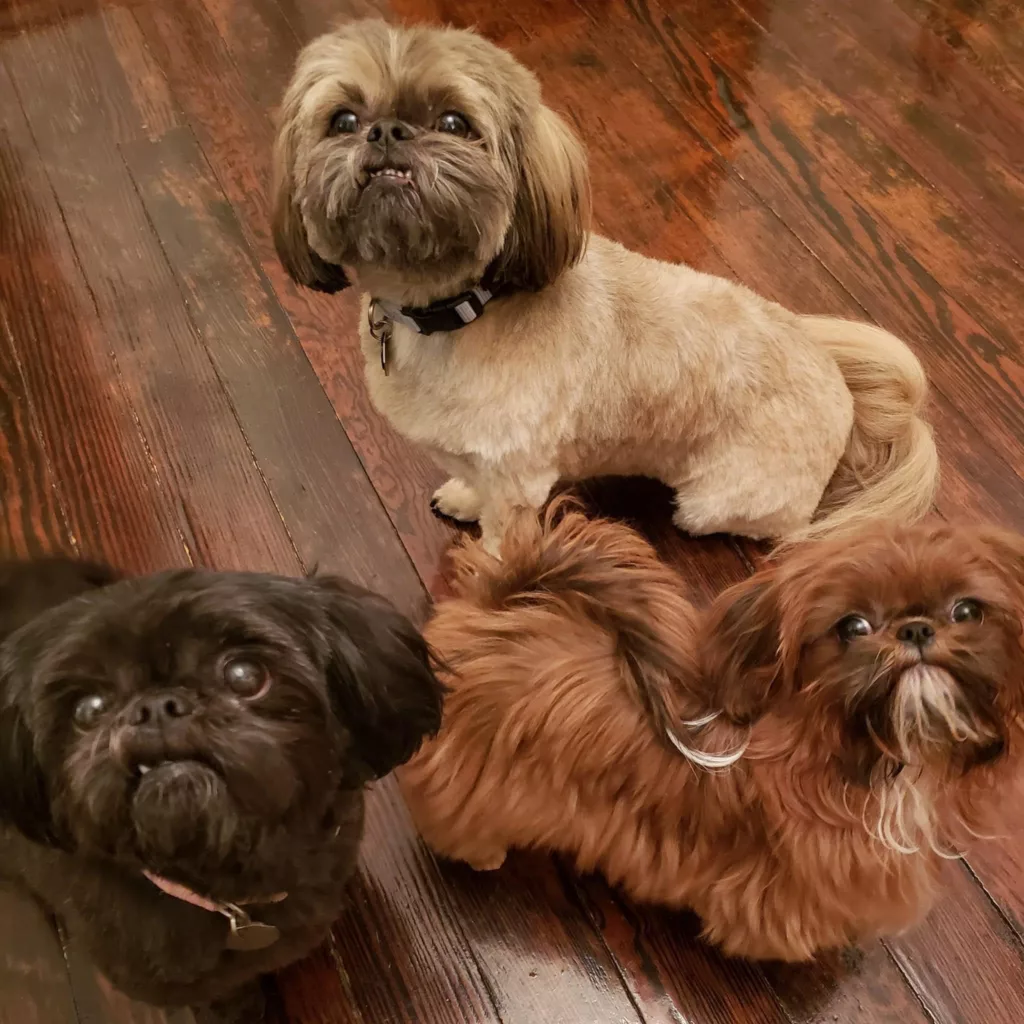
It is important to provide the breed with proper training and socialization. Otherwise, the cute little thing can become notoriously stubborn. Like many toy breeds, Shih Tzu also suffers from training neglect if owners often skip training. The animal is quite smart, and its stubborn streak will make it difficult to train it unless you are consistent, and gentle, and start training at an early age.
As the dogs are prone to anxiety due to their clingy behavior, they often develop negative temperaments. Proper training can help resolve the issue and make them a calm and friendly companions that can adjust if left alone from time to time.
Also, puppy training ensures that your puppy will develop into a happy dog with a great temperament. You will need time, effort, and a lot of patience, as you cannot train them overnight.
When To Start Training Shih Tzu?
This is a question that almost every new dog owner has. While previous dog experts believed that the optimal time to begin training was when the puppy was mature enough, this is no longer the case. Today, we know that the puppy should be started training as soon as possible after you bring the bundle of joy home.
Puppy training is more than just learning tricks. It’s a continuous process that incorporates the fundamental abilities that your pup needs on a daily basis. It aids the dog’s mannerisms and social skills, as well as its understanding of basic instructions and housebreaking. Manu puppies may go beyond the basics and learn more, but the basics are absolutely necessary for a well-functioning dog.
A well-trained puppy will be a beloved member of the family and will be less prone to develop bad tendencies. If you do not train your dog, it may become stubborn or develop anxiety disorders. Untrained canines are the ones who are most likely to enter a dog shelter or rescue.
Housebreaking And Crate Training
Housebreaking and crate training is at the top of every new puppy owner’s priority list, and rightfully so. There are various methods for housebreaking a puppy, and one must select ahead of time which strategy will work best for them.
Shih Tzus are difficult to housebreak, so you need to be consistent and diligent in training them, and begin at a young age.
Many people prefer to take their pets outdoors for elimination. Others, however, like an indoor litter box for their dogs. You need to keep the area clean as Shih Tzus tend to eat feces (theirs as well as other dogs’).
Although it will take a lot of time and effort, it is the most important investment that you will make on your new family member. Initially, the puppy may not understand or cooperate. However, with time, it will understand the routine and commands and will take over the responsibility.
Shih Tzu Puppy Biting
Puppies may chew or nip when they are young and going through their teething phase. Nipping is also their way of exploring the surroundings and must not be confused with aggressive behavior.
Puppies stop nipping as they mature. However, some may need training. It is important to stop their nipping behavior at a young age before it becomes a habit.
When your pup nips you, act similar to a hurt puppy. Cry out loud and turn away or look away. Losing you, that is, its favorite playmate is a punishment it will not forget easily. After some time, go back to playing with it, but this time, use a toy instead of your hand.
Some may take more time to understand it while most understand quickly and behave accordingly.
Most dogs end up in shelters due to their biting habits that intensify over time. So, it’s better not to take a chance on this one.
Walking On A Leash
Leash training involves normal walking without resistance, that is, no pulling away or making erratic movements. It means a nice stroll through your neighborhood without your dog pulling at you.
Most toy dog owners do not leash train their dogs as they think that the puppy can’t get too far out of their reach, and even if the dog does start troubling them, they can just hold them in their arms. This type of faulty thinking can get them in trouble. They deprive the puppy of training that is beneficial for both the puppy and owner.
Few dogs grasp the training quickly, but most require a few more opportunities to master it. You can use small treats to encourage them to learn quickly and look forward to walks.
Socialization
Puppies are good companions, but you cannot be sure if they develop into well-behaved, obedient, well-socialized adults. Through socialization, you can make sure they develop happy temperaments. Expose them to new people, places, other animals, and different sounds and surfaces.
Expose your puppy to as many stimuli as possible as soon as you bring them home. As they become more accustomed to various circumstances, their confidence will grow, resulting in better-tempered canines.
You can teach your dog obedience training, but it will be difficult, and you will need to be firm in order to overcome their resistance.
Because they are friendly with other dogs and cats, the dogs do well in a family with other pets, especially if they are introduced at a young age or are present from the start. They also work well with older children who are gentle with them.
Reward-Based Training
Shih Tzus are extremely sensitive to scolding and yelling and may misbehave when afraid. On the other hand, reward-based strategies are very effective and show quick results.
You can use a clicker and treat while teaching them basic commands. So when the dog follows your command to “sit” or “stay”, use the clicker to let the dog know it has displayed the desired behavior and follow it up with a treat.
As the breed is stubborn, you will need to practice new commands several times each day. Placing the puppy on a leash while training will grab their attention and prevent loss of focus.
Shih Tzu Nutrition
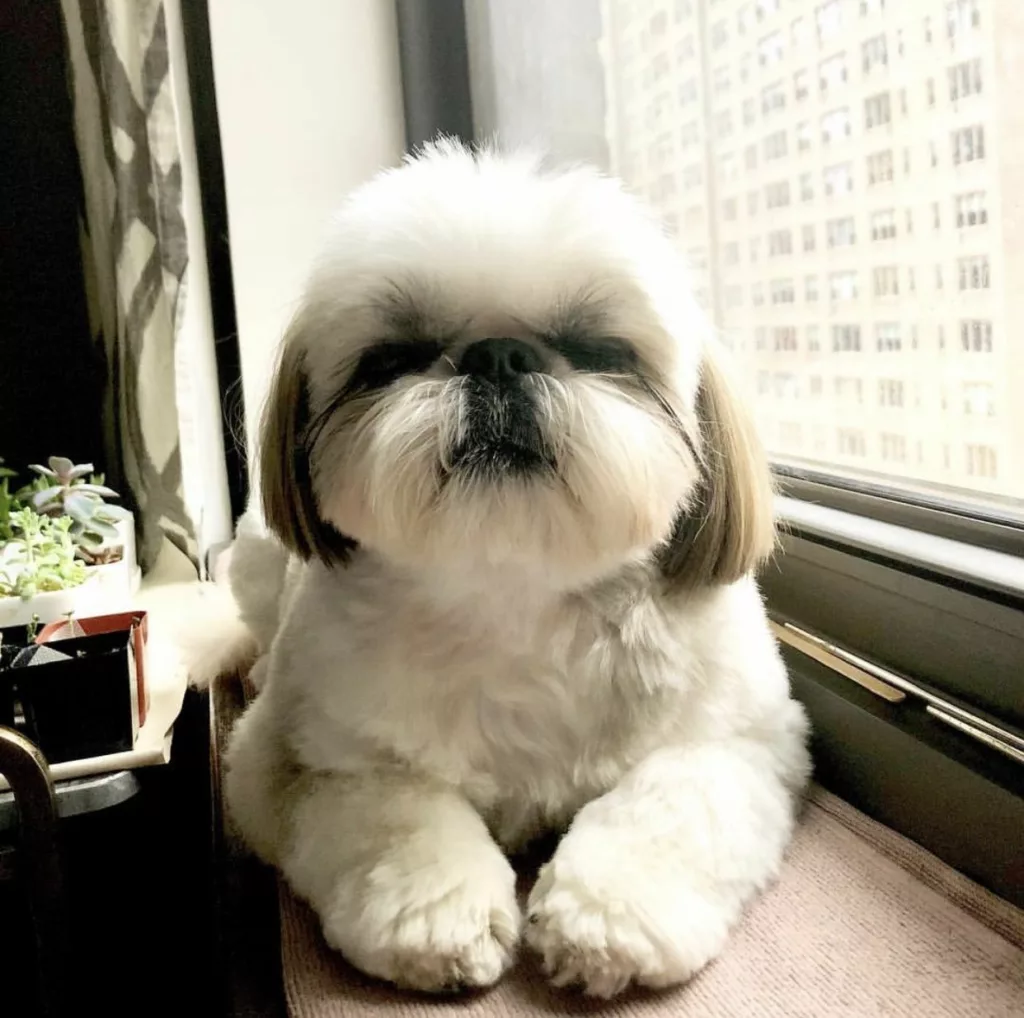
Although Shih Tzu are little dogs, they consume a lot of food. It is important to feed dogs quality and nutritious food to keep them healthy and happy.
How often should you feed a Shih Tzu?
How often you feed a Shih Tzu will depend on its age.
Puppies, 3 months old or younger: This is a phase of free feeding. This means the puppies have access to fresh food at all times. This helps avoid hypoglycemia, a condition characterized by a sudden drop in blood sugar levels. This occurs when a puppy goes without food for an extended period of time. Hypoglycemia is particularly common in Shih Tzu pups.
However, do not fill the bowl to the brim because leftovers may remain at the bottom of the feeding bowl and become stale, causing health problems. Also, because the puppies are so young, you will need to remind them of the location of the food and water bowls.
Puppies 3 to 12 months old: This is the time that the puppy has a stabilized growth rate and will need feeding 3 times a day.
Adults: Some dogs prefer two meals per day. However, you must complement it with snacks and treats to fulfill their daily caloric requirement. Some Shih Tzus prefer three meals per day.
How Much To Feed A Shih Tzu?
Several factors like activity level, build, age, and metabolism rate will determine how much you need to feed a Shih Tzu. The usual recommended daily amount is ½ to 1 cup of rich-quality dry food that contains all the necessary nutrients. Also, different types of dog foods have different calories.
Generally, you should give an ounce of food per pound of body weight to a puppy. An adult Shih Tzu will need 12 ounces of food per pound of body weight. The reason for this is obvious—puppies have a higher level of activity and need more calories to grow.
You can weigh your puppy and accordingly provide 35 calories/pound of body weight for an adult and 30 calories/pound of body weight for senior dogs. This method is more accurate and easily fulfills their daily requirements.
What Is The Best Dog Food For Shih Tzu Puppies?
Shih Tzu is more prone to obesity than other dog breeds, so you must limit their carbohydrate intake. Their diet must contain all the essentials including proteins and nutrients, especially for puppies as they are in their growing phase.
When it comes to puppies, obesity, stunted development, and starvation can all result from improper feeding or low-quality food. As a result, they require a high-quality meal that is particularly tailored for them.
Some ingredients to include in a Shih Tzu’s diet are liver, lamb, fish, chicken, raspberries, blueberries, sweet potato, sweet peas, baby carrots, green beans, pasta, cottage cheese, rice, and yogurt.
What Not To Feed A Shih Tzu?
Some foods can cause health issues in the breed. Intake of these foods can cause many health issues and can even be fatal at times. Some of the noted health issues are:
- problems in breathing
- fluids accumulation in the heart and abdomen
- paralysis and tremors
- coma
- kidney damage
- damage to the Red Blood Corpuscles (RBC)
To save your dog from these issues, avoid these toxic ingredients:
- grapes and raisins
- chocolate
- soda
- tea and coffee
- onions
- salt
- xylitol
- fruit pits and seeds
Choosing The Right Food For Your Shih Tzu
Food intake can either be beneficial or detrimental to the dog’s health.
When the food has additives and inferior quality ingredients, it can lead to many health issues, such as itchiness and digestive issues. Some foods also contain coloring agents, which may lead to cancer. Some examples of these additives are fillers, generic meats, and chemical additives.
On the other hand, high-quality food will be easily digestible yet provide natural and wholesome food and additives. They have added supplements and come in proper sizes to ensure they meet the dog’s requirements.
Shih Tzu Health

The breed has gained popularity, which has led to unethical breeding practices that have increased health issues in the breed. Some health issues that Shih Tzus face are:
Allergies: Shih Tzu suffers from allergies. They are of three types—food allergies caused by certain foods, contact allergies caused by topical substances, and inhalant allergies caused by allergens in the air.
The best treatment for allergies is the removal of the allergen if possible. Other treatments involve dietary restrictions and medication.
Brachycephalic Syndrome: This is a breathing problem that arises due to skull malformation. A Shih Tzu suffering from this syndrome has a short nose and upper jaw, which results in ineffective breathing. The conditions resulting from this syndrome are collapsed larynx, stenotic nare, trachea issues, and elongated soft palate.
If two or more of these conditions are present, they can lead to severe breathing issues. Treatments include using a collar and limited exercise. Severe cases may require surgery.
Intervertebral Disc Disease: This condition occurs when a spinal cord disc slips from its position and presses on the spinal cord. It often develops after 2 years of age and is very painful for the dog. It also causes weakness and spasms and can lead to paralysis if untreated.
Treatment involves medication and rest; however, dogs that do not respond to the first treatment may need surgery.
Patellar luxation: This is one of the most common orthopedic conditions and involves the dislocation of the kneecap. It is a congenital disease and is present at birth; however, it can develop at any time during the dog’s life. For mild conditions (for example, when only one leg is affected), treatment is not necessary. However, for severe cases, surgery is compulsory for the realignment of the kneecaps.
Juvenile Renal Dysplasia (JRD): This congenital disease develops early. The symptoms include uncurbed thirst and frequent rumination. The dogs tend to lose weight, lack strength and vomit a lot. The best treatment for the ailment is prevention, and the only available test done on breeding dogs is a biopsy which entails many risks.
Bladder stones and bladder infections: Many factors cause bladder stones—excess protein, phosphorus, and magnesium in the diet, or infrequent urination; while bladder infections are due to bacterial or viral infections. Symptoms include frequent urination, blood in urine, loss of appetite, and urinary hesitancy. Medication can usually treat the disease. However, severe cases may need surgery.
Eye problems: With large, bulging eyes, eye problems are common in the breed. Some of the most common problems are keratitis, the inflammation of the cornea leading to ulcer and blindness; progressive retinal atrophy, a degenerative disease progressing to blindness; distichiasis, abnormal growth of eyelashes; dry eye, dryness of the conjunctiva and cornea; and some others like ectopia cilia and proptosis.
Umbilical hernias: These occur when the abdominal midline closes late. When the condition is minor, it autocorrects as the puppy grows. However, for large hernias, surgery is compulsory.
Harderian Gland Prolapse: This is an eye condition commonly referred to as cherry eye. The tear ducts get detached from the third eyelid and settle in the corner of the eye as a swollen mass. These masses get inflamed and cause serious discomfort and infection. It is a congenital disease but can develop anytime during the dog’s lifetime.
If diagnosed early, a licensed veterinarian can massage the glands back to their original position.
Hypothyroidism: This is the malfunctioning of the thyroid gland leading to decreased production of thyroxine. Although it can develop at any age, it is more common in older dogs. Some symptoms are hair loss, heart problems, depression, weight gain, and lethargy. Medication helps treat hypothyroidism.
Portosystemic Liver Shunt: This is a congenital disease wherein the blood bypasses the liver through the blood vessels. As a result, the blood is not cleaned as required. This may lead to serious issues and warrants immediate surgery.
Snuffles: This is due to difficult teething, which leads to swelling of the gums. As the gums are right under the nose, the swelling not only causes discomfort but also snoring, snorting, snuffling, and even wheezing. At times, even nasal drainage may occur.
Reverse sneezing: This happens when your dog gulps food too fast or even due to allergens. This leads to the closing of the windpipe, and the dog may get alarmed due to shock. Talking to them soothingly shortens the episode.
Even though it sounds like a long list of health issues, if you purchase your Shih Tzu from a reputable dog breeder, many of these can be avoided. With our two Shih Tzu’s, we have not seen one of these issues yet, however, the above should be taken as more of a caution as to what can develop if you don’t put the time into researching reputable breeders in your area.
Conclusion
The Shih Tzu is a beautiful breed with aristocratic roots. They are fun, sociable, and obstinate. Their beautiful hair and large eyes are enough to make anyone fall in love with them. They mature quickly as they are short dogs and achieve their maximum height and weight within a year.
They may be the best companions if properly trained, and you can proudly show them off to relatives and friends. They require sufficient nourishment for overall development and to avoid a variety of health problems.
However, this breed has been our best friend for many years now and it’s a dog breed that we recommend to everyone who wants a companion.
